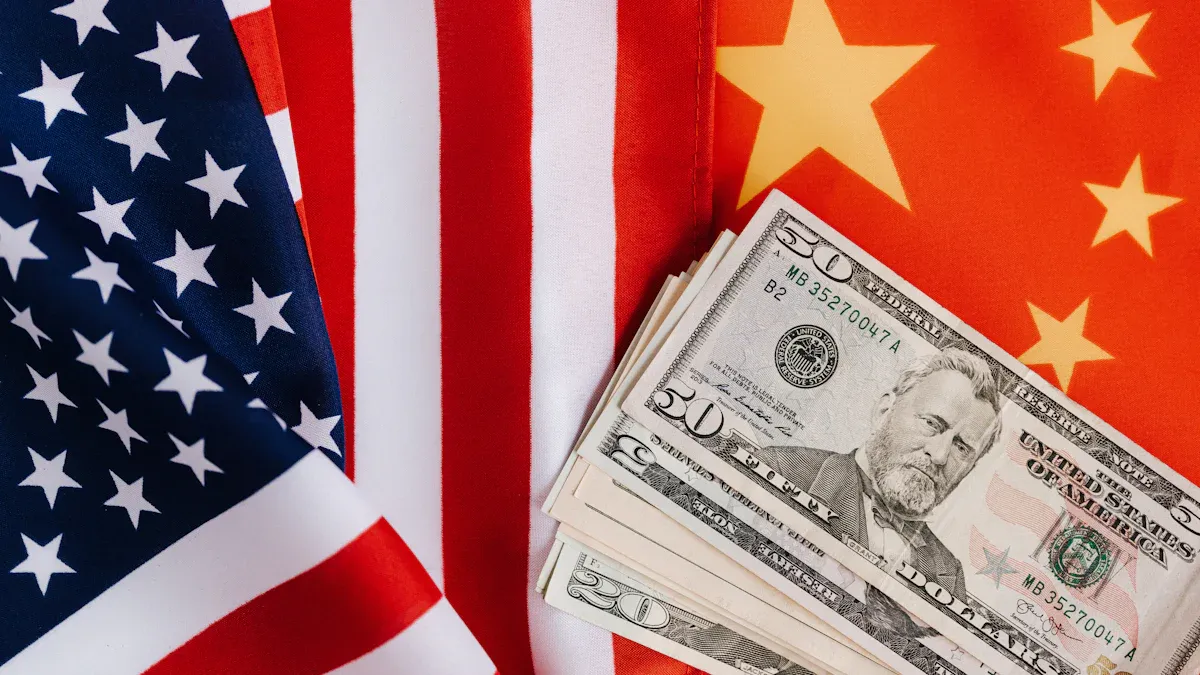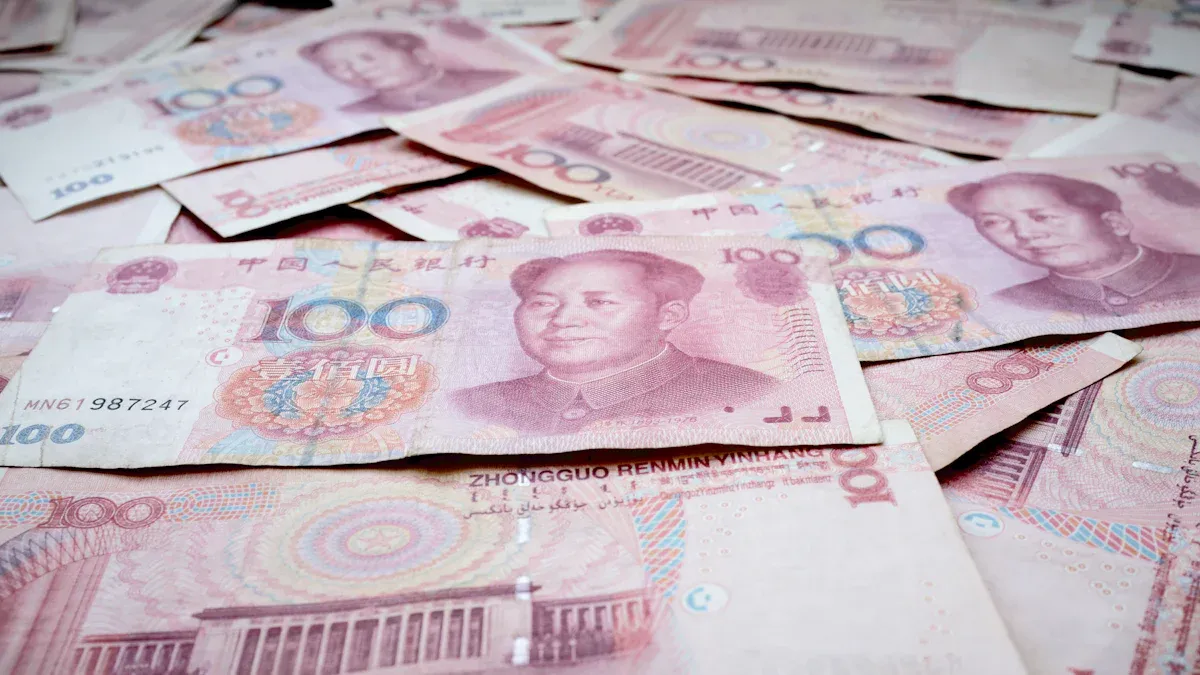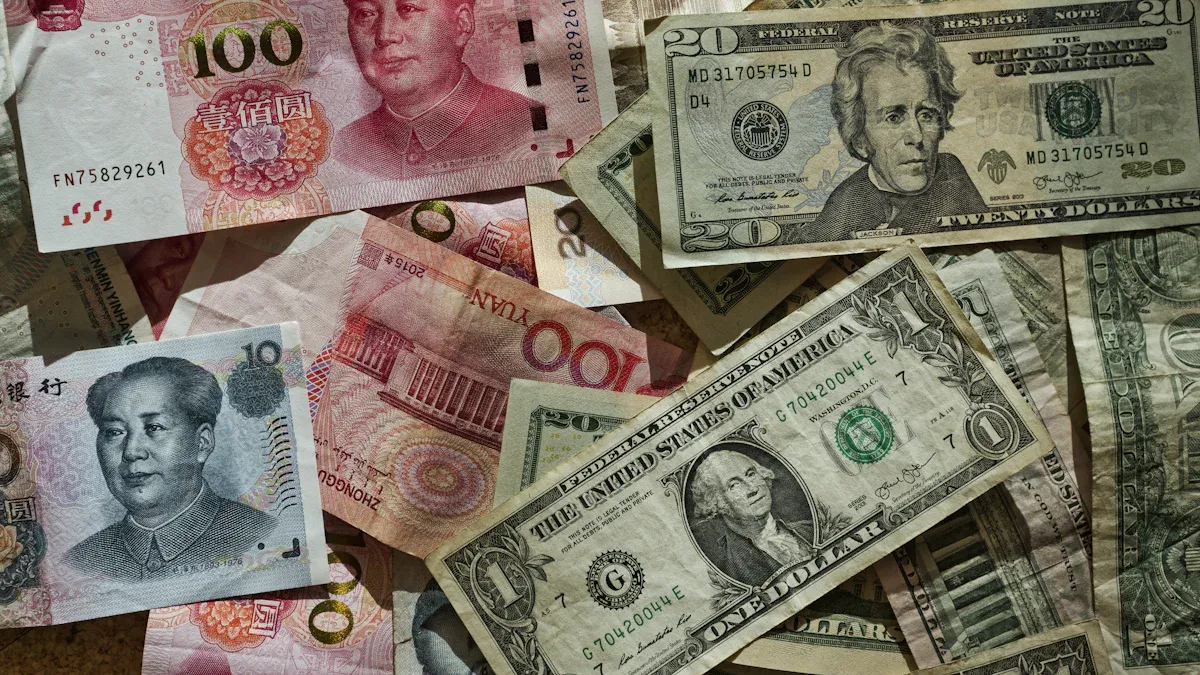- EasyCard
- Trade
- Help
- Announcement
- Academy
- SWIFT Code
- Iban Number
- Referral
- Customer Service
- Blog
- Creator
CNY versus CNH Understanding the Two Faces of Renminbi

Image Source: pexels
The difference between cny and cnh centers on where and how each version of the renminbi is used. CNY refers to rmb traded within Mainland China, where strict rules from the People’s Bank of China and capital controls apply. CNH, on the other hand, is traded in places like Hong Kong and follows market-driven pricing with fewer restrictions. These differences between renminbi types impact regulation, usage, and exchange rates. Recent data shows that CNH trading volumes have grown, with more global transactions handled through Hong Kong banks.
Key Takeaways
- CNY is the Chinese yuan used inside Mainland China with strict government controls, while CNH is the yuan traded freely outside China in places like Hong Kong.
- CNY supports daily transactions and regulated trade within China; CNH is used for international trade, investment, and faster cross-border payments.
- The exchange rate for CNY is managed by China’s central bank to keep it stable, but CNH rates change based on global market demand and can be more volatile.
- Businesses often prefer CNH for international deals because it offers more flexibility, faster payments, and lower risks of delays or extra costs.
- Understanding the differences between CNY and CNH helps individuals and companies choose the right currency for their needs and avoid payment problems.
Renminbi, CNY, and CNH

Image Source: unsplash
What Is Renminbi?
Renminbi is the official currency of China. The People’s Bank of China introduced it on December 1, 1948, and holds exclusive rights to issue it. The name means “people’s currency.” The basic unit of renminbi is the yuan. Banknotes range from 1 fen to 100 yuan, and coins go from 1 fen to 1 yuan. The term renminbi refers to the entire currency system, which includes yuan, jiao, and fen. Many people also call it the Chinese yuan or RMB. The Chinese renminbi is used for all official transactions in China.
CNY Explained
CNY stands for the Chinese yuan traded within Mainland China. This form of RMB operates under strict rules set by the People’s Bank of China. The onshore market for CNY is not fully open, so regulatory restrictions apply. CNY is the currency code used in international trading systems to represent the yuan in China. People use CNY for daily purchases, business transactions, and banking within China. The exchange rate for CNY is managed by the People’s Bank of China, which sets a daily reference rate against the United States dollar. This control helps keep the value of CNY stable. When people refer to the Chinese yuan in the context of China, they usually mean CNY.
Note: CNY is the only form of RMB that can be used for payments and settlements inside China. The People’s Bank of China monitors all CNY transactions closely.
CNH Explained
CNH is the Chinese yuan traded outside China, mainly in financial centers like Hong Kong, Singapore, London, and Luxembourg. The People’s Bank of China established the CNH market in 2009 to help international trade and investment. CNH operates with fewer restrictions than CNY. International banks, especially those in Hong Kong, handle most CNH transactions. The exchange rate for CNH is set by market forces, so it can change more quickly than CNY. CNH gives global investors and companies a way to use the yuan without following China’s strict capital controls.
| Characteristic | CNH (Offshore Yuan) |
|---|---|
| Regulation | Less regulated, traded freely in international markets |
| Exchange Rate | Determined by market forces, more volatile |
| Usage | International trade and investment |
| Accessibility | Available in Hong Kong, Singapore, London, Luxembourg |
| Established | 2009 by People’s Bank of China |
| Purpose | Promote yuan internationalization |
The CNH market has grown quickly over the past decade. It now plays a key role in setting the price of the Chinese yuan worldwide. When the RMB faces changes in demand or supply, the CNH market often reacts first. This system allows China to keep control over CNY while letting CNH reflect global market trends.
Differences Between Renminbi: CNY vs CNH
Regulation and Controls
The differences between renminbi start with how CNY and CNH are regulated. CNY, also known as the onshore Chinese yuan, operates under strict rules set by the People’s Bank of China and the State Administration of Foreign Exchange. These authorities control the flow of money, set daily trading bands, and limit how much currency can move in and out of China. This tight control helps keep the value of CNY stable and supports government policy.
CNH, the offshore version of the Chinese yuan, trades mainly in financial centers like Hong Kong, Singapore, and London. Offshore regulators, such as the Hong Kong Monetary Authority, oversee CNH markets. These markets do not face the same capital controls as CNY. As a result, CNH trades more freely, and its value can change quickly based on global supply and demand.
The State Administration of Foreign Exchange outlines that CNY is strictly regulated by Chinese authorities, while CNH is not subject to these controls and trades freely in offshore markets. This regulatory split creates two separate markets for the same currency.
Capital controls in China create a clear line between the onshore market for CNY and the offshore market for CNH. These controls restrict the free exchange between the two types of yuan, making it hard for traders to move money from one market to the other. When the Chinese yuan faces pressure, authorities can adjust liquidity and set new rules to keep the markets stable. For example, in 2015–16, a gap appeared between CNY and CNH exchange rates. The government responded by tightening flows and raising interbank rates, which helped restore balance.
Usage and Markets
The differences between renminbi also show up in how people and businesses use CNY and CNH. CNY is used for payments, purchases, and business deals inside China. It is the main currency for regulated trade and banking within the country. The onshore market for CNY includes banks and financial institutions that follow strict rules.
CNH, on the other hand, is used outside China. It is the preferred currency for international payments, global investments, and cross-border trade. Companies and investors use CNH to settle deals with Chinese partners, invest in Chinese assets, or issue bonds known as Dim Sum bonds. Hong Kong serves as the main hub for CNH trading, but Singapore and London also play important roles. London, for example, handles a large share of global foreign exchange trading and offers legal support for CNH transactions. The time zone overlap with China allows London to provide liquidity during Asian and European trading hours.
- CNY is used mainly inside China for daily transactions and regulated trade.
- CNH is used in global financial centers for international trade, investment, and payments.
- Hong Kong, Singapore, and London are the top markets for CNH trading.
The differences between renminbi in usage mean that CNY supports China’s internal economy, while CNH helps connect China to the world.
Exchange Rate Differences
Exchange rates for CNY and CNH show another key difference between renminbi. The People’s Bank of China sets a daily reference rate for CNY and allows it to move within a narrow band, usually about 2% above or below the set rate. This system keeps the onshore Chinese yuan stable and predictable.
CNH, in contrast, has a free-floating exchange rate. Offshore markets decide the value of CNH based on supply and demand. This means CNH can be more volatile than CNY, especially during times of economic stress or global uncertainty. For example, when the yuan weakens against the US dollar, the gap between CNY and CNH can grow. Authorities may step in to adjust liquidity or change rules to keep the gap from getting too wide.
The International Monetary Fund recognizes this split. CNY remains tightly managed, while CNH reflects global market forces. This dual system allows China to control its internal currency while supporting the international use of RMB.
Comparison Table
The following table summarizes the main differences between CNY and CNH in terms of regulation, usage, exchange rates, and market access:
| Aspect | CNY (Onshore Renminbi) | CNH (Offshore Renminbi) |
|---|---|---|
| Regulation | Controlled by People’s Bank of China and SAFE; strict capital controls | Overseen by offshore regulators (e.g., HKMA); fewer controls |
| Usage | Used for payments and trade within China | Used for international payments, investments, and cross-border trade |
| Exchange Rate Mechanism | Managed by PBOC with a daily reference rate and narrow trading band | Market-driven, free-floating, more volatile |
| Market Access | Limited to banks and residents in China | Accessible to global investors and traders |
| Trading Locations | Onshore market in China | Offshore centers: Hong Kong, Singapore, London |
| Flexibility | Low; tightly controlled | High; freely traded |
| Payment Speed | May face delays due to regulations | Faster, more efficient payments |
| Cost Efficiency | Can be higher due to rigid structure | Often more cost-effective in favorable market conditions |
Key distinctions between CNY and CNH:
- CNY is tightly regulated and used inside China, while CNH is traded freely in global markets.
- Exchange rates for CNY are managed and stable; CNH rates are set by the market and can change quickly.
- CNH offers more flexibility and faster payments for international trade.
- The differences between renminbi in regulation, usage, and exchange rates create two separate markets for the Chinese yuan.
Why Two Types of Renminbi?
Currency Controls
China maintains two types of renminbi to manage currency flows and protect its financial system. The onshore renminbi, known as CNY, operates under strict rules. The People’s Bank of China and the State Administration of Foreign Exchange set these rules. They require approval for spot foreign exchange transactions involving CNY, especially for capital account conversions. These controls limit how easily people and companies can convert CNY into other currencies. The restrictions help prevent large, sudden movements of money that could destabilize the economy.
Unlike traditional capital controls that act as taxes, China’s system can prohibit certain spot conversions, regardless of the price. This approach keeps the onshore market for CNY separate from other markets. As a result, the convertibility of CNY remains tightly regulated. The exchange rate for CNY stays stable because the central bank manages it with daily reference rates and trading bands. When market conditions change, the relationship between CNY and offshore renminbi can shift, showing the impact of these currency controls.
Note: Currency controls in China create a segmented environment. CNY remains restricted onshore, while offshore renminbi enjoys greater flexibility.
Offshore Market Purpose
China introduced the offshore renminbi, called CNH, to support the international use of its currency. The offshore market began in 2010, with Hong Kong banks playing a leading role in cnh trading. This market allows foreign companies to invest in China using RMB instead of US dollars. CNH operates with fewer restrictions, so its exchange rate reflects global supply and demand.
The main reasons for maintaining two types of renminbi include:
- Control currency and capital flows, allowing the central bank to manage price fluctuations and avoid speculative attacks.
- Support the gradual internationalization of RMB by enabling foreign investment through offshore renminbi.
- Encourage exports and help create a balance of payments surplus.
- Stabilize the onshore renminbi through managed exchange rates.
- Separate the offshore market, letting global financial centers like Hong Kong handle international trading while China keeps its monetary policy stable.
The offshore market gives investors and companies more flexibility. CNH trading in places like Hong Kong, Singapore, and London helps set the global price for RMB. This dual system lets China open its currency to the world while keeping control at home.
CNY and CNH Exchange Rates

Image Source: unsplash
How Rates Differ
CNY and CNH exchange rates follow different rules. The People’s Bank of China sets the CNY exchange rate each day. This rate uses a reference value against the United States dollar, and the CNY can only move within a narrow band. The central bank uses capital controls, trading limits, and direct intervention to keep the CNY stable. In contrast, the CNH exchange rate is set by offshore market forces. Hong Kong banks and other global financial centers trade CNH freely, so its value changes more quickly.
After China’s exchange rate reform in August 2015, the offshore CNH market started to play a bigger role in price discovery. The People’s Bank of China tightened control over the onshore CNY, but the CNH market became more important for setting the global price of the Chinese yuan. The main reason for the divergence between CNY and CNH exchange rates comes from these different market environments. The CNY market remains stable due to policy controls, while the CNH market reacts to global investor sentiment and external news.
Note: The CNH exchange rate often shows more volatility and can move away from the CNY rate, especially during economic shocks or major news events.
Real-World Examples
Several events have shown how CNY and CNH exchange rates can diverge. During the 2008 global financial crisis, China pegged the CNY to the United States dollar, keeping the USD/CNY rate between $6.81 and $6.85. The CNH market did not exist yet, but later events showed bigger differences. In 2018, the US-China trade war caused the USD/CNH rate to rise from $6.24 to $6.96, while the USD/CNY rate moved from $6.24 to $6.93. The CNH rate changed more and reacted faster to global news.
- The CNH is usually slightly weaker than the CNY, especially when the yuan faces pressure.
- Policy interventions by China often stabilize the CNY first, which can lead to temporary gaps between the two exchange rates.
- When CNH supply increases, the CNH can depreciate quickly, but these gaps often close within a few days as markets adjust.
These examples show that while CNY and CNH exchange rates are linked, they can move apart during times of stress. Investors and businesses should watch both rates when dealing with the Chinese yuan.
Practical Implications: CNY and CNH
Sending and Receiving Money
Individuals and businesses use different methods to send and receive money in CNY and CNH. People often use platforms like UnionPay, Alipay, and Weixin for CNY transfers. These services require the recipient to have a Chinese National ID or a CNY account in China. Limits apply, such as up to $7,000 (about 50,000 CNY) per transfer on Alipay or Weixin, with annual caps for recipients. Businesses prefer Hong Kong banks for CNH transactions because these banks offer better liquidity and faster settlements. Many companies open CNH accounts to lower conversion costs and improve cash flow for regular payments. Fintech platforms also help by providing real-time CNH access and quicker processing than traditional banks.
| Method | Who Uses It | Currency | Requirements | Limit per Transfer (USD) |
|---|---|---|---|---|
| UnionPay | Individuals | CNY | Chinese National ID | Varies |
| Alipay/Weixin | Individuals | CNY | Chinese National ID | Up to $7,000 |
| Local Banks | Businesses | CNY | CNY account in China | Varies |
| Hong Kong Banks | Businesses | CNH | CNH account | Varies |
Tips for Transactions
Financial experts recommend several strategies for smooth CNY and CNH transactions:
- Use multi-currency business accounts to send and receive CNY directly, which improves payment efficiency.
- Choose fintech platforms that specialize in cross-border payments to reduce complexity.
- Work with Hong Kong banks or financial institutions experienced in China-related trade.
- Open CNY-denominated bank accounts for easier payments and receipts.
- Integrate accounting software to track CNY transactions automatically.
- Use multi-currency virtual payment cards to avoid foreign exchange fees.
- Employ international money transfer services in CNY to manage exchange rate risks.
Tip: Understanding the regulatory differences between CNY and CNH helps businesses choose the right payment method and avoid delays.
Risks and Considerations
Currency risk remains a major concern when dealing with CNY and CNH. The two markets have different liquidity and exchange rate mechanisms. Exchange rates for CNH can change quickly, while CNY rates stay more stable. Companies often use hedging tools like forward contracts to manage this risk. Fully hedged portfolios tend to perform better than unhedged ones, with investors willing to pay premiums to reduce risk. The partial disconnect between CNY and CNH markets can lead to volatility spillover and systemic risks, especially during market stress.
International investors see CNH as more volatile but easier to trade, while CNY is more controlled and less accessible. Policy changes in China can affect both markets, so businesses and investors must monitor regulations and use dynamic hedging strategies.
Differences Between CNY and CNH for Business
International Trade
Businesses trading with partners in China must choose between two types of yuan. This choice affects how they manage payments, costs, and risks. Companies often prefer to use the offshore yuan for international trade. The offshore yuan offers more flexibility and fewer restrictions than the onshore yuan. The onshore yuan is controlled by the Chinese government, which sets strict rules for buying, selling, and transferring funds. These rules can make payments slow and complicated. Companies must provide payment purpose codes and go through approval steps.
The offshore yuan, traded mainly in Hong Kong, does not have these limits. Companies can buy and sell it freely. This freedom helps them avoid delays and high costs. Many businesses use the offshore yuan to hedge against currency risks and to access the Chinese market more easily. When companies set up trade agreements, they must consider these differences:
- The onshore yuan requires following strict rules and may cause payment delays.
- The offshore yuan allows faster, market-driven transactions.
- Using the offshore yuan helps companies avoid high exchange rates and extra steps.
- The choice between the two affects transaction costs, complexity, and risk management.
Companies that use the offshore yuan in trade agreements often find it easier to manage payments and reduce costs.
Cross-Border Payments
The process for sending money across borders changes depending on which type of yuan a business uses. The table below shows the main differences:
| Aspect | CNY (Onshore Yuan) | CNH (Offshore Yuan) |
|---|---|---|
| Usage Location | China | Outside China (e.g., Hong Kong) |
| Payment Network | China’s local clearing house and CIPS | SWIFT network |
| Transaction Speed | Same day or next day | 2-3 days |
| Transaction Cost | Lower, avoids third-party fees | Higher, includes intermediary fees |
| Currency Conversion | No conversion needed within China | Conversion to onshore yuan required |
| Currency Rate Volatility | Less volatile, regulated | More volatile, market-driven |
| Payment Complexity | Simpler, direct to suppliers | More complex, may use third-party apps |
| Impact on Business | Improves supplier relationships and cash flow | May cause delays and higher costs |
A typical cross-border payment using the offshore yuan follows these steps:
- The customer’s funds, such as USD, are collected.
- The funds move from the customer’s sub-account to the payment provider’s master account.
- The provider converts the funds into offshore yuan.
- The offshore yuan is sent through the SWIFT network to a correspondent bank in China.
- The correspondent bank converts the offshore yuan to onshore yuan at a 1:1 rate and deposits the money into the supplier’s account.
Hong Kong banks play a key role in handling offshore yuan payments, offering global businesses access to China’s market with greater speed and flexibility.
The main differences between CNY and CNH appear in where each trades, how each is regulated, and who can use them. The table below shows these points clearly:
| Aspect | CNY (Onshore Renminbi) | CNH (Offshore Renminbi) |
|---|---|---|
| Market | Mainland China | Outside China (e.g., Hong Kong) |
| Regulation | Controlled by PBOC and SAFE | Regulated by Hong Kong Monetary Authority |
| Trading Restrictions | Yes | No |
| Usage Context | Transactions within China | International and offshore transactions |
| Currency Conversion | 1:1 with CNH in China; rates differ abroad | 1:1 with CNY in China; rates differ abroad |
People and businesses should check which type of Renminbi fits their needs. Choosing the right currency helps avoid extra costs and delays. Using trusted payment providers and staying updated on currency rules can make transactions smoother.
FAQ
What is the main difference between CNY and CNH?
CNY is the Chinese yuan used inside China and follows strict rules. CNH is the Chinese yuan traded outside China, such as in Hong Kong, and has fewer restrictions. The exchange rates for CNY and CNH can differ.
Can people outside China open a CNY bank account?
People outside China usually cannot open a CNY bank account. Most international banks, especially in Hong Kong, offer CNH accounts for global clients. These accounts allow easy access to the offshore yuan.
Why do CNY and CNH exchange rates sometimes differ?
The People’s Bank of China controls the CNY rate. CNH rates depend on market supply and demand. When global events affect the yuan, CNH rates can change faster than CNY rates.
Which type of yuan should businesses use for international trade?
Businesses often choose CNH for international trade. CNH offers more flexibility and faster payments. Hong Kong banks provide CNH services, making cross-border transactions easier and more efficient.
Cross-border transfers shouldn’t leave you stuck weighing high fees against complicated processes. Choose BiyaPay, where you can check and exchange fiat currencies and digital currencies in real time, enjoy a transparent fee structure with remittance fees as low as 0.5%, and in most cases, achieve same-day remittance delivery. Whether for personal remittances or corporate settlements, BiyaPay helps you cut costs, boost efficiency, and make fund flows more secure and reliable.
Register now at BiyaPay to experience fast remittance services covering most countries and regions around the world.
*This article is provided for general information purposes and does not constitute legal, tax or other professional advice from BiyaPay or its subsidiaries and its affiliates, and it is not intended as a substitute for obtaining advice from a financial advisor or any other professional.
We make no representations, warranties or warranties, express or implied, as to the accuracy, completeness or timeliness of the contents of this publication.




Contact Us
Company and Team
BiyaPay Products
Customer Services
is a broker-dealer registered with the U.S. Securities and Exchange Commission (SEC) (No.: 802-127417), member of the Financial Industry Regulatory Authority (FINRA) (CRD: 325027), member of the Securities Investor Protection Corporation (SIPC), and regulated by FINRA and SEC.
registered with the US Financial Crimes Enforcement Network (FinCEN), as a Money Services Business (MSB), registration number: 31000218637349, and regulated by FinCEN.
registered as Financial Service Provider (FSP number: FSP1007221) in New Zealand, and is a member of the Financial Dispute Resolution Scheme, a New Zealand independent dispute resolution service provider.




















